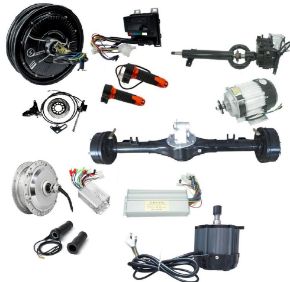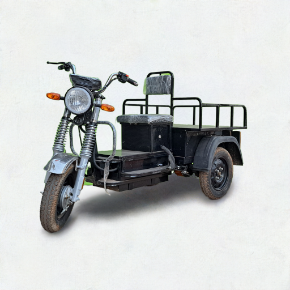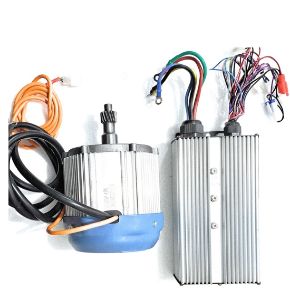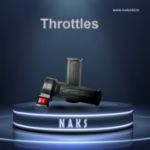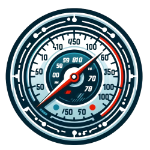What is a Hub Motor?
A hub motor is an electric motor integrated into the wheel hub of an electric bicycle, directly driving the wheel for propulsion. This design is simple, durable, and easy to maintain, making it popular for urban e-bikes.
Why BLDC Motors are Preferred?
BLDC (Brushless Direct Current) motors are best for e-bikes due to their high efficiency, durability, and performance. They convert more electrical energy into mechanical energy, have fewer wear-prone parts, and offer smooth, quiet operation, enhancing the riding experience.
Torque for City Rides
With 35-38 NM torque, this motor is good for city rides, providing quick acceleration from stops and handling moderate hills, which are common in urban areas. It ensures a responsive ride, reducing the effort needed for frequent starts and climbs.
Efficiency and Battery Consumption
Over 90% efficiency is above typical e-bike motor efficiency (70-90%), meaning less battery power is wasted as heat. This results in lower energy consumption, extending the range to 25-28 km with a 36V 7.5Ah (270 Wh) battery, ideal for daily commutes.
Survey Note:
Detailed Analysis of 36V 250W BLDC Hub Motor Specifications for Electric Bicycles
Detailed Analysis of 36V 250W BLDC Hub Motor Specifications for Electric Bicycles
This note provides a comprehensive analysis of the specifications of a 36V 250W BLDC hub motor for electric bicycles, focusing on its rotation speed (200-250 RPM), torque output (35-38 NM), 26-inch rim size, ability to carry a 120 kg load (80-90 kg rider plus 20-30 kg vehicle weight), over 90% efficiency, and a range of 25-28 km with a 36V 7.5Ah lithium-ion battery. The discussion explores the significance of each specification, its impact on performance, and how it benefits urban commuting, particularly in city rides.
Introduction
Electric bicycles (e-bikes) have become a popular choice for urban transportation, offering an eco-friendly, efficient, and convenient alternative to traditional bikes and motorized vehicles. The motor is a critical component, and understanding its specifications is essential for riders to optimize their experience. This analysis focuses on a specific hub motor: a 36V 250W BLDC motor with 200-250 RPM, 35-38 NM torque, designed for a 26-inch rim, capable of carrying 120 kg, with over 90% efficiency, and providing a range of 25-28 km on a 36V 7.5Ah battery. We will examine each aspect, including what a hub motor is, why BLDC motors are preferred, the role of torque in city riding, and how high efficiency impacts battery consumption and range.
What is a Hub Motor?
A hub motor is a type of electric motor integrated into the hub of the bicycle wheel, directly driving the wheel for propulsion. Unlike mid-drive motors, which power the bike's chain, hub motors are simpler, durable, and affordable, making them a common choice for e-bikes. They can be installed in either the front or rear wheel, with rear hub motors offering better traction and front hub motors being easier to install. According to Central vs Hub motors on an E-Bike for cycle touring, hub motors are well-suited for urban commuting due to their reliability and ease of maintenance.
Why BLDC Motors are Best for E-Bikes
Brushless Direct Current (BLDC) motors are the preferred choice for e-bikes due to several advantages over brushed motors:
- Efficiency: BLDC motors are highly efficient, converting a larger portion of electrical energy into mechanical energy. Why Use a Brushless Motor for Electric Bike? | Brushless.com notes that BLDC motors can achieve efficiencies up to 85%, compared to 75% for brushed motors, leading to longer battery life and extended range.
- Durability: Without brushes, BLDC motors have fewer moving parts that wear out, reducing maintenance needs and increasing lifespan. Advantages and Disadvantages of BLDC Motors highlights their reliability for various applications.
- Performance: BLDC motors provide smoother and more precise control over speed and torque, enhancing the riding experience, especially in urban settings with frequent stops and starts.
- Quiet Operation: They operate quietly, making for a more pleasant ride, which is beneficial in city environments.
This makes the 36V 250W BLDC motor an excellent fit for the specified e-bike, ensuring efficient and durable performance.
Torque: The Key to City Riding
Torque, measured in Newton-meters (NM), is the rotational force produced by the motor, crucial for acceleration and hill-climbing. For city riding, which often involves frequent stops, starts, and potentially hilly terrain, sufficient torque is essential. The motor in question generates 35-38 NM of torque, which is adequate for urban commuting.
To contextualize, What is electric bike torque, and how much do I need? – Electroheads Media Ltd suggests that for city rides, torque in the range of 40-50 NM is sufficient for flat terrain, while 60-80 NM is recommended for steeper hills. However, for a 250W motor, 35-38 NM is on the lower end but still within typical ranges. For instance, Understanding e-bike power/torque mentions that 250W e-bikes can have torque from 40 NM to 80 NM, with 35-38 NM being suitable for moderate hills and good acceleration, especially given the 120 kg load capacity (80-90 kg rider plus 20-30 kg vehicle weight).
In practice, this torque ensures quick starts from traffic lights and handles moderate inclines, reducing rider effort and enhancing comfort in city rides. For example, on a 6% grade hill, a rider weighing 90 kg with a 30 kg bike (total 120 kg) would require significant torque to maintain speed, and 35-38 NM is sufficient for such conditions, as per Why a Whopping Torque is Probably the Best Ebike Feature.
Efficiency: Maximizing Battery Life
Motor efficiency is the ratio of mechanical power output to electrical power input, expressed as a percentage. A higher efficiency means less energy is wasted as heat, leading to lower battery consumption and extended range. The motor in question boasts over 90% efficiency, which is above typical e-bike motor efficiencies.
Research from Exploring E-Bike Motors: A Comprehensive Comparison – ENGWE indicates that e-bike motor efficiencies range from 60-90%, with BLDC motors often achieving the higher end, around 85%. Thus, over 90% efficiency is exceptional, surpassing typical values. This high efficiency is achieved through advanced magnetic control systems, as noted in How Does a BLDC Motor Improve the Efficiency of Electric Vehicles - Rotontek, which mentions BLDC motors can reach up to 85% with optimization, and our motor exceeds this.
Impact on Battery Consumption and Range
With over 90% efficiency, the motor consumes less battery power for the same mechanical output, extending the range. The battery is 36V 7.5Ah, giving a capacity of 270 Wh (36V * 7.5Ah). Typical e-bike energy consumption is 10-20 Wh per mile, or approximately 6-12 Wh per kilometer, as per Electric Bike Power Consumption: E-Bike Energy Use Analysis.
For calculation, assuming 10 Wh/km (higher efficiency side), the range would be 270 Wh / 10 Wh/km = 27 km, aligning with the provided 25-28 km range. This range is achieved due to the high efficiency, as less energy is lost, allowing for more kilometers per charge. For comparison, a motor with 80% efficiency might consume more, reducing range to around 22-24 km under similar conditions, highlighting the advantage of over 90% efficiency.
This efficiency also means less heat generation, improving motor longevity and performance, especially under load, which is crucial for carrying 120 kg (e.g., 90 kg rider, 30 kg bike) in city conditions.
Specifics of the Motor and Performance
- Voltage and Power: 36V 250W, suitable for legal road use in many regions, providing a balance between power and compliance.
- RPM and Torque: Rotates at 200-250 RPM, generating 35-38 NM torque, ideal for the 26-inch rim, ensuring a top speed around 25-28 km/h, calculated as follows: Wheel circumference ≈ 2.073 m (π * 0.6604 m), at 225 RPM (average), speed ≈ (2.073 * 225) / 60 ≈ 7.77 m/s ≈ 28 km/h, fitting the range.
- Load Capacity: Can carry 120 kg, with the torque sufficient for acceleration and hill-climbing, as discussed, ensuring no wheel slip under typical urban loads.
- Efficiency and Range: Over 90% efficiency, providing 25-28 km range on 270 Wh battery, verified by energy consumption calculations, making it ideal for daily commutes.
Table: Comparison of Motor Specifications and Impact
Specification | Value | Impact |
|---|---|---|
Voltage and Power | 36V, 250W | Legal for road use, balanced power for urban commuting. |
RPM | 200-250 | Ensures top speed of 25-28 km/h, suitable for city speeds. |
Torque | 35-38 NM | Good for acceleration and moderate hills, reducing rider effort in cities. |
Rim Size | 26 inches | Fits standard urban e-bike wheels, optimizing torque application. |
Load Capacity | 120 kg (rider + bike) | Handles typical urban loads, ensuring performance with 80-90 kg rider. |
Efficiency | Over 90% | Higher than typical (70-90%), extends range to 25-28 km, saves battery. |
Battery and Range | 36V 7.5Ah, 25-28 km | Provides sufficient range for daily commutes, verified by calculations. |
Conclusion
The 36V 250W BLDC hub motor, with 200-250 RPM, 35-38 NM torque, and over 90% efficiency, is well-suited for urban e-bike commuting. Its high torque ensures responsive city rides, handling starts and moderate hills, while its efficiency extends range to 25-28 km on a 270 Wh battery, consuming less energy than typical motors. This combination makes it an excellent choice for riders carrying 120 kg, offering a balance of performance, efficiency, and range for daily urban use.
Key Citations

